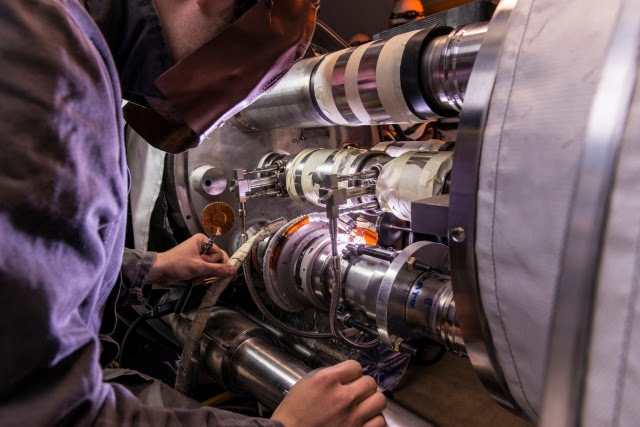
Geneva, Dec 3 (IBNS): Early this morning, operators of the CERN Control Centre turned off the Large Hadron Collider (LHC), ending the very successful second run of the world’s most powerful particle accelerator. CERN’s accelerator complex will be stopped for about two years to enable major upgrade and renovation works.
During this second run (2015–2018), the LHC performed beyond expectations, achieving approximately 16 million billion proton-proton collisions at an energy of 13 TeV and large datasets for lead-lead collisions at an energy of 5.02 TeV.
These collisions produced an enormous amount of data, with more than 300 petabytes (300 million gigabytes) now permanently archived in CERN’s data centre tape libraries.
This is the equivalent of 1000 years of 24/7 video streaming! By analysing these data, the LHC experiments have already produced a large amount of results, extending our knowledge of fundamental physics and of the Universe.
“The second run of the LHC has been impressive, as we could deliver well beyond our objectives and expectations, producing five times more data than during the first run, at the unprecedented energy of 13 TeV,” says Frédérick Bordry, CERN Director for Accelerators and Technology. “With this second long shutdown starting now, we will prepare the machine for even more collisions at the design energy of 14 TeV.”
“In addition to many other beautiful results, over the past few years the LHC experiments have made tremendous progress in the understanding of the properties of the Higgs boson,” adds Fabiola Gianotti, CERN Director-General. “The Higgs boson is a special particle, very different from the other elementary particles observed so far; its properties may give us useful indications about physics beyond the Standard Model.”
A cornerstone of the Standard Model of particle physics – the theory that best describes the elementary particles and the forces that bind them together – the Higgs boson was discovered at CERN in 2012 and has been studied ever since. In particular, physicists are analysing the way it decays or transforms into other particles, to check the Standard Model’s predictions. Over the last three years, the LHC experiments extended the measurements of rates of Higgs boson decays, including the most common, but hard-to-detect, decay into bottom quarks, and the rare production of a Higgs boson in association with top quarks.The ATLAS and CMS experiments also presented updated measurement of the Higgs boson mass with the best precision to date.
Beside the Higgs boson, the LHC experiments produced a wide range of results and hundreds of scientific publications, including the discovery of exotic new particles such as Ξcc++ and pentaquarks with the LHCb experiment, and the unveiling of so-far unobserved phenomena in proton–proton and proton-lead collisions at ALICE.
During the two-year break, Long Shutdown 2 (LS2), the whole accelerator complex and detectors will be reinforced and upgraded for the next LHC run, starting in 2021, and the High-Luminosity LHC (HL-LHC) project, which will start operation after 2025. Increasing the luminosity of the LHC means producing far more data.
“The rich harvest of the second run enables the researchers to look for very rare processes,” explains Eckhard Elsen, Director for Research and Computing at CERN. “They will be busy throughout the shutdown examining the huge data sample for possible signatures of new physics that haven’t had the chance to emerge from the dominant contribution of the Standard Model processes. This will guide us into the HL-LHC when the data sample will increase by yet another order of magnitude.”
Several components of the accelerator chain (injectors) that feed the LHC with protons will be renewed to produce more intense beams. The first link in this chain, the linear accelerator Linac2, will leave the floor to Linac4. The new linear accelerator will accelerate H- ions, which are later stripped to protons, allowing the preparation of brighter beams. The second accelerator in the chain, the Proton Synchrotron Booster, will be equipped with completely new injection and acceleration systems. The Super Proton Synchrotron (SPS), the last injector before the LHC, will have new radio frequency power to accelerate higher beam intensities, and will be connected to upgraded transfer lines.
Some improvements of the LHC are also planned during LS2. The bypass diodes – the electrical components that protect the magnets in case of quench – will be shielded, as prerequisite for extending the LHC beam energy to 7 TeV after the LS2, and more than 20 main superconducting magnets will be replaced. Moreover, civil engineering works for the HL-LHC that started in June 2018 will continue, new galleries will be connected to the LHC tunnel, and new powerful magnet and superconducting technologies will be tested for the first time.
All the LHC experiments will upgrade important parts of their detectors in the next two years. Almost the entire LHCb experiment will be replaced with faster detector components that will enable the collaboration to record events at full proton-proton rate. Similarly, ALICE will upgrade the technology of its tracking detectors. ATLAS and CMS will undergo improvements and start to prepare for the big experiments’ upgrade for HL-LHC.
Proton beams will resume in spring 2021 with the LHC’s third run.
Support Our Journalism
We cannot do without you.. your contribution supports unbiased journalism
IBNS is not driven by any ism- not wokeism, not racism, not skewed secularism, not hyper right-wing or left liberal ideals, nor by any hardline religious beliefs or hyper nationalism. We want to serve you good old objective news, as they are. We do not judge or preach. We let people decide for themselves. We only try to present factual and well-sourced news.







